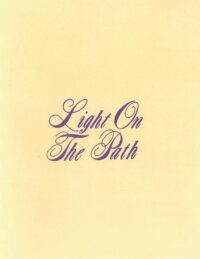Light on the Path and an Essay on Karma (Standard)
By Mabel Collins (1851-1927).
81 Pages | First Adyar Edition 1911, Adyar Centenary Edition 1982, second reprint 2000 | Hardcover | Theosophical Publishing House, Adyar | ISBN: 8170590116.
Dutch publication: Licht op het Pad, part of the publication Drie Wegen, Een Pad | First published in 2006 | Hardcover | Uitgeverij der Theosofische Vereniging in Nederland | ISBN: 9061750881.
'A TREATISE, Written for the personal use of those, who are ignorant of the Eastern Wisdom and who desire to enter within its influence. Written down by MC'.
The book itself begins with the statement, that 'These rules are written for all disciples'. The latter description is surely the more accurate one, as the history of the book will show. As we have it at present it was dictated by the Master Hilarion through the mediumship of M.C. - a lady well known in Theosophical circles, who at one time collaborated with Helena Petrovna Blavatsky in the editorship of Lucifer. The Master Hilarion received it from his own Teacher, the Great One. One, who among Theosophical students is sometimes called 'The Venetian'; but even He is the author only of part of it. It has passed through three phases; let us set them down in order.
" These rules are written for all disciples: Attend you to them.Before the eyes can see they must be incapable of tears. Before the ear can hear it must have lost its sensitiveness. Before the voice can speak in the presence of the Masters it must have lost the power to wound. Before the soul can stand in the presence of the Masters its feet must be washed in the blood of the heart. "
 Bezig met bijwerken...
Bezig met bijwerken...